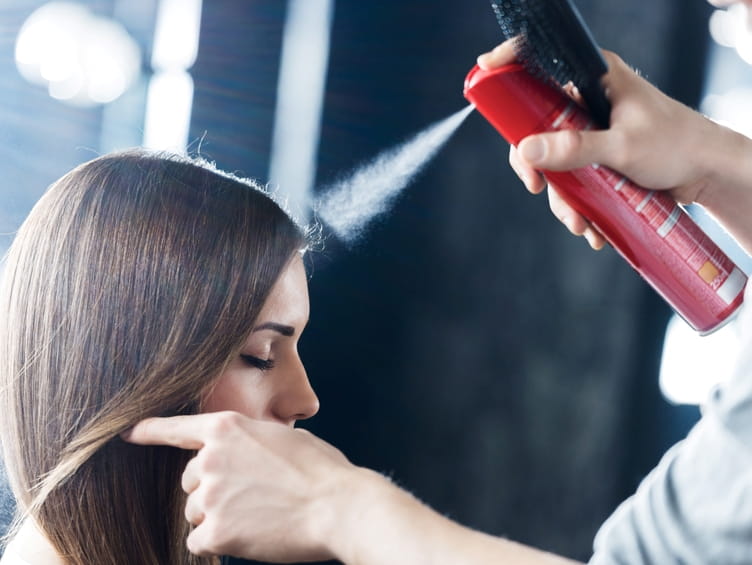The Safety of Hairspray

The Bottom Line
When used as directed, hairspray is minimally toxic. Unintentional eye contact, inhalation, or ingestion of small amounts of hairspray might produce minor irritating effects. Irritation should improve by rinsing the eyes or mouth or getting fresh air. Deliberate swallowing or inhaling hairspray can be very dangerous.

The Full Story
Hairspray came into vogue after World War II when the cosmetics industry adopted the use of aerosol spray technology developed by the Department of Agriculture for use with insect sprays during the war. This transfer of technology to the business of beauty helped make women’s hair styles such as the beehive and the bouffant possible. Although the use of hairspray has declined with the popularity of more “natural” hairstyles, hairspray is commonly used by men and women today.
Today’s typical hairspray contains polymers (chain-like molecules) in a solvent and sometimes a propellant. After spraying, the solvent evaporates and leaves behind a stiff layer of the polymers on the hair to help keep it in place. The propellant is usually a liquefied gas under pressure that forces the hairspray out of an aerosol can and produces a mist. Sometimes the propellant is also the solvent. Due to health and environmental concerns, the US Food and Drug Administration (FDA) banned certain propellants (e.g., chlorofluorocarbons and vinyl chloride) from use in hairsprays. An example of a propellant used in hairsprays today is isobutane. Non-aerosol hairsprays, such as pump sprays, do not contain a propellant. A common solvent used in hairsprays is alcohol. While exact formulations vary depending on the manufacturer, hairsprays often include essential oils or fragrances as well as conditioning agents and silicone.
When used as directed, hairsprays should be very low in toxicity. Some hairspray inevitably gets on the skin. Some people might have an allergic reaction to the product - usually a red itchy rash that is uncomfortable but not dangerous. Any hairspray that gets on the skin should be promptly washed off.
The FDA warns that some hairsprays contain flammable solvents or propellants. These might catch fire if used around an open flame, hot surface, or other source of ignition. The user or others nearby might be injured. A woman who tried to light a cigarette before her hairspray had dried died from burns.
Unintentional exposures to hairsprays are common and include getting the spray in the eyes, breathing in the fumes or mist, and swallowing hairspray. Small amounts of hairspray in the eyes are expected to produce mild redness and pain that should get better after a thorough rinsing. In the unusual situation where the aerosol nozzle was right next to the eye when the can was sprayed, injury could happen just from the force of the spray. This kind of injury needs to be checked out right away by an emergency physician or an ophthalmologist.
Hairspray should always be used in a well-ventilated area. Briefly inhaling a small amount of hairspray might cause some coughing, choking, or difficulty catching the breath. These effects should get better quickly with breathing fresh air. If anyone is having difficulty breathing that does not get much better soon after getting fresh air, emergency medical services (e.g., 911) should be called. Professional hair stylists repeatedly inhale airborne chemicals from hair products. A research study of hair stylists found that stylists often had coughing, breathlessness, sneezing, and wheezing from inhaling these products. The most irritating products were bleaching powders and hairspray. The study also found that some of the hair stylists had decreased lung function compared to people who did not work with these products. So while occasional inhalation of hairspray should not be dangerous, repeated exposures may have negative health effects.
Unintentional swallowing of small amounts of hairspray is usually not dangerous. The polymers and silicone are non-toxic when ingested; the ingredient of concern is the alcohol. Hairsprays typically are about 25-50% alcohol. Distilled alcoholic beverages, such as vodka or whiskey, are about 40% alcohol. Just like with drinking alcoholic beverages, anyone ingesting too much alcohol-containing hairspray can become intoxicated. Fortunately, unintentional ingestions usually involve small amounts and are not expected to cause intoxication. Even if a toddler manages to unscrew the top of a pump spray bottle, it is not likely that more than a mouthful or two would be ingested. However, it is best to contact Poison Control or check the webPOISONCONTROL® online tool for guidance if a child swallows any amount of hairspray. Anyone who gets hairspray in their mouth should rinse out the mouth right away.
Not all ingestions of hairspray are unintentional. Some teenagers and adults intentionally swallow large amounts of hairspray specifically to become intoxicated. This often happens when alcoholic beverages are not available or affordable. The health problems of alcohol abuse are well established. The added toxicities of swallowing large amounts of the other components of hairspray are less well known.
Another type of abuse of hairspray involves inhalation of the fumes to get intoxicated. Inhalation of volatile substances is a major problem in some societies. These substances include liquids such as paint thinner and gasoline and aerosols such as spray paint and hairspray. The chemicals in these products are inhaled into the lungs, absorbed into the blood stream, and enter the brain. When the chemicals enter the brain, the user quickly feels “high” but may also develop toxicities such as muscle weakness, violent behavior, seizures, and loss of consciousness. The “high” only last a short time, so users will often repeat the inhalations several times in a short period to remain intoxicated. Inhalation of aerosols has caused sudden death because the heart suddenly stops working correctly.
If you suspect someone has swallowed or inhaled hairspray or gotten it in the eye or on the skin, immediately check the webPOISONCONTROL online tool for guidance or call Poison Control at 1-800-222-1222.
Karen D. Dominguez, PharmD
Certified Specialist in Poison Information
Poisoned?
Call 1-800-222-1222 or
Prevention Tips
- Keep hairspray out of reach of children.
- Always use hairspray in a well-ventilated space.
- Never use hairspray near an open flame, hot surface, or other source of ignition.
This Really Happened
Case 1. A mother called Poison Control because her 2-year-old son unintentionally swallowed hairspray from a sample bottle. The boy was not having symptoms. The exact amount swallowed was unknown, but it was a 1 ounce bottle and there was still some liquid remaining in the bottle. Poison Control was able to calculate how much of the product would have to be swallowed to cause a problem. The amount swallowed by the boy was much less than a toxic dose and no medical care was needed. A follow-up call was done and the boy remained fine.
Case 2. A mother called Poison Control because her 2- and 4-year-old sons were spraying each other in the face with hairspray! None was thought to be swallowed. At the time of the call, the 4 year old had red eyes and some swelling of the skin around his eyes. The 2-year-old had no symptoms. The mom was instructed how to safely irrigate the 4-year-old boy’s eyes at home. A follow-up call was made about an hour later and the eyes were much improved. No medical evaluation was necessary.
Case 3. A man called Poison Control because his wife had intended to use a breath spray but unintentionally used hairspray instead. She was fine at the time of the call, but they were concerned about her being poisoned by hairspray. Poison Control advised that there was a possibility of minor irritation and the only treatment needed was rinsing her mouth.
For More Information
General Chemistry Online. What Is Hairspray Made of?
References
Alani JI, Davis MD, Yiannias JA. Allergy to cosmetics: a literature review. Dermatitis 2013;24:283-90.
Flanagan RJ, Ives RJ. Volatile substance abuse. Bull Narc 1994;46:49-78.
Prohibited and restricted ingredients, FDA. accessed 6/10/2016
Hashemi N, Boskabady MH, Nazari A. Occupational exposures and obstructive lung disease: a case-control study in hairdressers. Respir Care 2010;55:895-900.
FDA warning: hairspray may catch fire. accessed 6/10/2016
Poisoned?
Call 1-800-222-1222 or
Prevention Tips
- Keep hairspray out of reach of children.
- Always use hairspray in a well-ventilated space.
- Never use hairspray near an open flame, hot surface, or other source of ignition.
This Really Happened
Case 1. A mother called Poison Control because her 2-year-old son unintentionally swallowed hairspray from a sample bottle. The boy was not having symptoms. The exact amount swallowed was unknown, but it was a 1 ounce bottle and there was still some liquid remaining in the bottle. Poison Control was able to calculate how much of the product would have to be swallowed to cause a problem. The amount swallowed by the boy was much less than a toxic dose and no medical care was needed. A follow-up call was done and the boy remained fine.
Case 2. A mother called Poison Control because her 2- and 4-year-old sons were spraying each other in the face with hairspray! None was thought to be swallowed. At the time of the call, the 4 year old had red eyes and some swelling of the skin around his eyes. The 2-year-old had no symptoms. The mom was instructed how to safely irrigate the 4-year-old boy’s eyes at home. A follow-up call was made about an hour later and the eyes were much improved. No medical evaluation was necessary.
Case 3. A man called Poison Control because his wife had intended to use a breath spray but unintentionally used hairspray instead. She was fine at the time of the call, but they were concerned about her being poisoned by hairspray. Poison Control advised that there was a possibility of minor irritation and the only treatment needed was rinsing her mouth.
